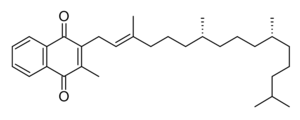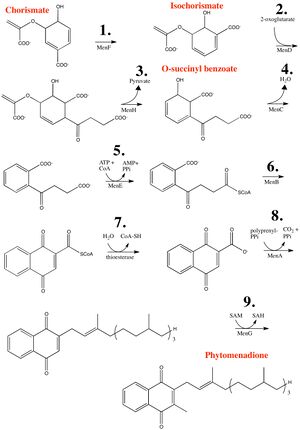فيلوكينون
| فادي الحمود ساهم بشكل رئيسي في تحرير هذا المقال
|
 | |
| البيانات السريرية | |
|---|---|
| الأسماء التجارية | Mephyton, others |
| أسماء أخرى | Vitamin K1, phytonadione, phylloquinone, (E)-phytonadione |
| AHFS/Drugs.com | Monograph |
| مسارات الدواء | by mouth, subQ, IM, IV |
| رمز ATC | |
| الحالة القانونية | |
| الحالة القانونية |
|
| المعرفات | |
| |
| رقم CAS | |
| PubChem CID | |
| DrugBank | |
| ChemSpider | |
| UNII | |
| ChEBI | |
| ChEMBL | |
| CompTox Dashboard (EPA) | |
| ECHA InfoCard | 100.001.422 |
| Chemical and physical data | |
| التركيب | C31H46O2 |
| الكتلة المولية | 450٫71 g·mol−1 |
| 3D model (JSmol) | |
| |
| |
الفيلوكينون Phylloquinone هو كيتون عطري متعدد الحلقات، قاعدته الأساسية 2-ميثل-1,4-naphthoquinoneمع 3-phytyl substituent. وهو فيتامين قابل للذوبات في الدهون، ثابت في الهواء والرطوبة لكنه يتحلل تحت ضوء الشمس. ويوجد طبيعيا في مجموعة واسعة من النباتات الخضراء.[1][2] As a supplement it is used to treat certain bleeding disorders.[2] This includes warfarin overdose, vitamin K deficiency, and obstructive jaundice.[2] It is also recommended to prevent and treat vitamin K deficiency bleeding in infants.[2] Use is typically recommended by mouth, intramuscular injection or injection under the skin.[2] When given by injection benefits are seen within two hours.[2] Many countries in the world choose intramuscular injections in newborn to keep them safe from severe bleeding (VKDB). It is considered a safe treatment and saves many children from death and severe neurologic deficit every year. [3]
التسمية
عادة ما يطلق عليه فيتامين ك1[4] أو فيتوناديون. وأحيانا ما يتم التمييز بين الفيلوكينون على أنه طبيعيا والفيتوناديون على أنه مادة مصنعة.[5]
يطلق على المتزامر الفراغي أو الفيلوكينون اسم فيتامين ك1 (لاحظ الاختلاف في الكتابة).
آلية العمل
يتبع فيتامين ك1 النظام الخمائري للكبد فيساعدالكبد على بناء عوامل التخثر الثاني والسابع والتاسع والعاشر وحين تعاكس مضادات التخثر من زمرة الكومارين عمل ك1و، ذلك بإبعاده عن النظام الخمائري للكبد فإن وظيفة الفيتامين ك هي القيام بعمل مضاد نوعي لمستحضرات الكومارين وغيرهامن مضادات التخثر. يستخدم ك1 في علاج النزيف الناتج عن نقص العامل الثاني أو عامل التخر السابع والتاسع والعاشر في الدم نقص البروثرومبين الغريزي لدى الرضع النزيف الناتج عن فرط الكومارين أو مشتقاته والأمراض المرافقة بنقص الفيتامين ك1 كاليرقان الإنسدادي وتناذر سوء الامتصاص.
الوظيفة الحيوية
The best-known function of vitamin K in animals is as a cofactor in the formation of coagulation factors II (prothrombin), VII, IX, and X by the liver. It is also required for the formation of anticoagulant factors protein C and S. It is commonly used to treat warfarin toxicity, and as an antidote for coumatetralyl.
Vitamin K is required for bone protein formation.
التصنيع الحيوي
Vitamin K1 is synthesized from chorismate, a compound produced from shikimate via the shikimate pathway. The conversion of chorismate to vitamin K1 comprises a series of nine steps:[6][7]
- Chorismate is isomerized to isochorismate by isochorismate synthase, or MenF (menaquinone enzyme).
- Addition of 2-oxoglutarate to isochorismate by PHYLLO, a multifunctional protein comprising three different enzymatic activities (MenD, H, and C).
- Elimination of pyruvate by PHYLLO.
- Aromatization to yield o-succinyl benzoate by PHYLLO.
- O-succinylbenzoate activation to corresponding CoA ester by MenE.
- Naphthoate ring formation by naphthoate synthase (MenB/NS).
- Thiolytic release of CoA by a thioesterase (MenH).
- Attachment of phytol chain to the naphthoate ring (MenA/ABC4).
- Methylation of the precursor at position 3 (MenG).
Vitamin K1 is required for plant photosynthesis, where it participates in the Photosystem I electron transport chain. As a result, it is rich in leaves.[8]
انظر أيضا
المصادر
- ^ Watson RR (2014). Diet and Exercise in Cystic Fibrosis (in الإنجليزية). Academic Press. p. 187. ISBN 9780128005880. Archived from the original on 2016-12-30.
- ^ أ ب ت ث ج ح "Phytonadione". The American Society of Health-System Pharmacists. Archived from the original on 29 December 2016. Retrieved 8 December 2016.
- ^ "American Academy of Pediatrics on vitamin k in the newborn period".
{{cite web}}:|archive-date=requires|archive-url=(help) - ^ Haroon Y, Shearer MJ, Rahim S, Gunn WG, McEnery G, Barkhan P (1982). "The content of phylloquinone (vitamin K1) in human milk, cows' milk and infant formula foods determined by high-performance liquid chromatography". J. Nutr. 112 (6): 1105–17. PMID 7086539.
{{cite journal}}: Unknown parameter|month=ignored (help)CS1 maint: multiple names: authors list (link) - ^ "Vitamin K". Retrieved 2009-03-18.
- ^ Reumann S (2013). "Biosynthesis of vitamin K1 (phylloquinone) by plant peroxisomes and its integration into signaling molecule synthesis pathways". Peroxisomes and their Key Role in Cellular Signaling and Metabolism. Subcellular Biochemistry. Vol. 69. Springer Netherlands. pp. 213–29. doi:10.1007/978-94-007-6889-5_12. ISBN 9789400768888. PMID 23821151.
- ^ Widhalm JR, van Oostende C, Furt F, Basset GJ (April 2009). "A dedicated thioesterase of the Hotdog-fold family is required for the biosynthesis of the naphthoquinone ring of vitamin K1". Proceedings of the National Academy of Sciences of the United States of America. 106 (14): 5599–603. Bibcode:2009PNAS..106.5599W. doi:10.1073/pnas.0900738106. PMC 2660889. PMID 19321747.
- ^ Basset GJ, Latimer S, Fatihi A, Soubeyrand E, Block A (2017). "Phylloquinone (Vitamin K1): Occurrence, Biosynthesis and Functions". Mini Rev Med Chem. 17 (12): 1028–38. doi:10.2174/1389557516666160623082714. PMID 27337968.
وصلات خارجية
- "Phytomenadione". Drug Information Portal. U.S. National Library of Medicine.
- CS1 errors: archive-url
- CS1 errors: unsupported parameter
- Template:drugs.com link with non-standard subpage
- ECHA InfoCard ID from Wikidata
- Articles without KEGG source
- Articles containing unverified chemical infoboxes
- مقالات ناطقة
- فيتامينات
- 1,4-Naphthoquinones
- Vitamers
- Vitamin K
- World Health Organization essential medicines
- Diterpenes
